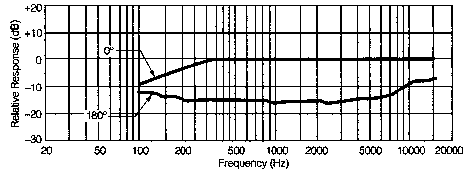
Freq. char. of Panasonc WM-55A capsule in free air.
|
High quality unidirectional floor microphone |
The electrets element.
For this uni-directional floor microphone (see "PCC" in this Crown publication),
a Panasonic WM-55A 9,7mm back electrets capsule was used. It was chosen for its very flat and extended high frequency response, good Signal-to-Noise
ratio, low price and good availability.
Order an original Panasonic WM-55A to be sure to have top quality !

Freq. char. of Panasonc WM-55A capsule in free air.
REM : if you purchase an unknown type or brand, you probably end up with one having a unpleasant 6dB peak around 8kHz.
Construction.
The capsule is glued into one end of a 12mm dia metal tube. This tube supports the capsule at ca. 8cm distance from the electronics box, and acts as a
grounded screening for the 3 twisted microphone signal wires. The 8cm distance ensures little obstruction for sound waves coming from behind, to keep a good directive response. The
tube contains acoustic damping material to prevent unwanted resonance's.
All cardioids-type microphone elements need also sound input from the rear. Therefore, immediately behind the capsules position, some sound holes are drilled in the tube.
VERY IMPORTANT: The front of the microphone element HAS to rest against the base plate as close as possible.
This is in order to prevent so called "phasing" and consequently unwanted ripples in the high frequency response (above 5kHz). The tube is therefore angled, from the center of the side of the box, down to the base plate. To prevent mechanical or electrical contact (and a possible ground loop => hum), the tube end is electrically isolated from the base plate by means of a drop of flexible glue.
Every hollow tube shows unwanted "organ pipe" resonance's, which should damage the frequency response. Between the sound holes and the open tube end inside the box, the tube is therefore completely filled with sound damping foam. The sound holes must however remain open.
To affix the tube firmly into the box, and to be sure that the tube makes perfect mass-contact, a small self tapping screw is tightly screwed in the seem between tube and box.
Every condenser type microphone capsule is very sensitive to static hum, noises and to wind.
Therefore a metal "mesh" MUST be installed in front of the capsule and over the sound holes (see photos).
Over that all MUST be a foam cap tot damp wind noises. This cap is secured in place by a second piece of grounded metal mesh.
|
|
|
|
|
|
|
|
|
Click-rigth on a picture to download.
HUM and noise.
Only with the mixers GAIN + Hi EQ + MID EQ ( ! ) turned up to the max (+15dB), the microphones "hiss" (high frequency electronic noise) became
noticeable in the acoustic background of a silent Atrium near my apartment..
I own some commercial condenser and dynamic mikes, which have output transformers. These microphone bodies produce hum when near mains wires and transformers.
Now this transformer less unidirectional floor mike design: with gain at max and EQ low at a practical 15:00 hrs and
- the screened capsule hold very close to a circulair fluorescent lamp (known to be noisy),
- after that to the accompanying choke,
- to the coiled mains cable and transformer of the mixer console,
- or the microphone cable itself coiled around these objects,
NO hum, rattle or noise was noticeable in the acoustic background of my room.
Only a weak hum was noticeable when the bottom of the ALU box was placed directly on top of the external mains transformer of the used mixer.
TWIST the wires inside the box and the tube. Keep all wire trios exactly at equal length !